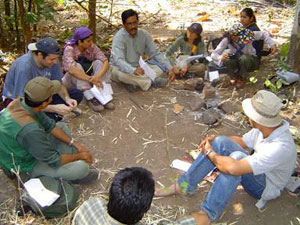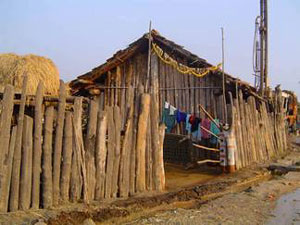(Contd. From last ezine)
- Saraswati Kavula
 While going through the village of Udhampur , we stopped at a bore pump to drink some water. I noticed cotton fields and inquired about the crop, they did not get a good crop this time. “we had a lot of pest, although we used monochrotophos
and endosulphan', one of the villagers replied. Both pesticides have been banned abroad, but sold extensively in all villages in Andhra. The villagers do not know the facts about the pesticides and simply trust the shopkeeper for advice on the pesticides.
I did not have much time to discuss the issue with the people there.
While going through the village of Udhampur , we stopped at a bore pump to drink some water. I noticed cotton fields and inquired about the crop, they did not get a good crop this time. “we had a lot of pest, although we used monochrotophos
and endosulphan', one of the villagers replied. Both pesticides have been banned abroad, but sold extensively in all villages in Andhra. The villagers do not know the facts about the pesticides and simply trust the shopkeeper for advice on the pesticides.
I did not have much time to discuss the issue with the people there.
We went to the main road, thinking that if the jeep is not there, we could go by the local bus. So we waited at the village teashop, which also happens to be the main centre for the village. I asked the man to give me tea in a steel
glass. He was surprised. Then we discussed about the harmful effects of plastic. Our discussion veered towards the impact of plastics on forest. Some villagers gathered around us. I asked, ‘what is the situation in your village?' They said, ‘there is no water'.
I replied, ‘how can you find water if you continue to cut down the forest around you?' To which one man said, well, see people here are too poor, so what can they do except for cutting down the wood to make a living? Look at me, look at him, we all are broke',
he said pointing to one of his neighbours. Then an argument ensued. The neighbouring man to whom the first one pointed got angry, ‘who is a beggar? Speak for yourself. I work hard, and I earn good money, you spend all your time drinking and end up in debts,
I am a Maratha and I work hard!” the man retorted. I told the first guy, ‘he is right, the reason for our backwardness is also our lazy attitude, the Marathas and Punjabis prosper because they work hard.
The Maratha man spoke up, ‘see madam, this fellow is always drunk, who will give him work and how can he make money if he doesn't till his land?' I asked the first man, ‘do people drink here?' the first man said, ‘yes, we all drink gudumba,
but you must ask the gudumba man to stop selling gudumba!' I told him, ‘well as long as there are people like you who drink, they will always make it. First you must stop drinking', to which all except our drunken friend agreed and nodded. We would have continued
our discussion, but I was called out to join the others in the auto. Since, we waited a while and assumed that the jeep wasn't coming; we all filed into the auto rickshaw and started towards Jannaram. On our way, we came across a forest fire. And we all got
down to douse the flames and managed to put - off the fire. Linganna said, ‘someone did it on purpose'. The rest of the evening passed off uneventfully except for meeting Anwar ali the man
selling pan at Jannaram in front of the Udipi hotel. Swetha asked him where he was from, ‘I am also from Hyderabad , and I came here during the communal riots in the 80's. I have my relatives here, they asked me to come over here and
ever since I have been living here'. He was happy to see people from his home town and reduced the price of pan by fifty paisa.
The next day morning, we left at 6am in the jeep, to go to the machaan inside the tiger habitat. But before that we went towards gangapur village. We could only see some Sambhar and chinkaara, groups of them and of course some langoors
and lots of birds. About five to six kilometres from the village, we found a whole area of forest was cut down. It was a freshly cut forest and nearly 60-70 year old trees were chopped down. In the middle of the clearing, we found a wooden cross used by the
Gonds to represent their spirits. Surely, it was an encroachment of the forest. “this seems to be a fresh encroachment and it is not even close to the village, so it cannot be a podu land either', Imran said. Towards 8 o clock we reached Gangapur village.
It had some thirty five households and it was mix of backward castes and tribes as well. Almost all houses were made in the traditional fashion using teak beams and mud tiles. Some were brick wall and tile roof houses like the plain areas. There was a drilling
machine, drilling a bore well. Some people were gathered around that place. One of them was the chairperson of the local Vana Samrakshana Samiti.
 I asked him, “How many trees do you use to make one house.” That man answered sheepishly, “Big and small together about 40 to 50 trees'. Some discussion followed amongst villagers, “yes, about four to five big ones and twenty to
thirty small ones!' they replied. I asked him, “How often do you rebuild your house?” ‘Well one house lasts for about twenty years and then we make a new one!' And of course, when the son gets married, he makes his new house and so on and so forth. One of
the members asked the man, ‘if you cut down the forest at this rate, nothing will be left here, have you thought why you were not getting the water?” The villagers replied, “What can we do, we cannot afford to buy building material, so we cut the trees'. Then
the VSS chairman replied, “actually collector amma came here and then cancelled the funds for our VSS, she even warned us that if we cut down any trees, she will not allow us the quota of rice from the ration shops. What can we do amma, we need to have a roof
on the head as well isn't it?' So we replied, ‘ask the collector to make you pucca houses'. ‘Who had cleared the forest five kilometres from here?” we inquired. “The Gonds from Laxmipur which is two kilometres from here have done it', the villagers replied.
“Seems like people have started to encroach on fresh land, in the hope of the land distribution scheme of the Chief Minister', Imran remarked.
I asked him, “How many trees do you use to make one house.” That man answered sheepishly, “Big and small together about 40 to 50 trees'. Some discussion followed amongst villagers, “yes, about four to five big ones and twenty to
thirty small ones!' they replied. I asked him, “How often do you rebuild your house?” ‘Well one house lasts for about twenty years and then we make a new one!' And of course, when the son gets married, he makes his new house and so on and so forth. One of
the members asked the man, ‘if you cut down the forest at this rate, nothing will be left here, have you thought why you were not getting the water?” The villagers replied, “What can we do, we cannot afford to buy building material, so we cut the trees'. Then
the VSS chairman replied, “actually collector amma came here and then cancelled the funds for our VSS, she even warned us that if we cut down any trees, she will not allow us the quota of rice from the ration shops. What can we do amma, we need to have a roof
on the head as well isn't it?' So we replied, ‘ask the collector to make you pucca houses'. ‘Who had cleared the forest five kilometres from here?” we inquired. “The Gonds from Laxmipur which is two kilometres from here have done it', the villagers replied.
“Seems like people have started to encroach on fresh land, in the hope of the land distribution scheme of the Chief Minister', Imran remarked.
(Photo credits: tribal hut-Saraswati Kavula, Trekking team-Akhil)
(To be concluded)